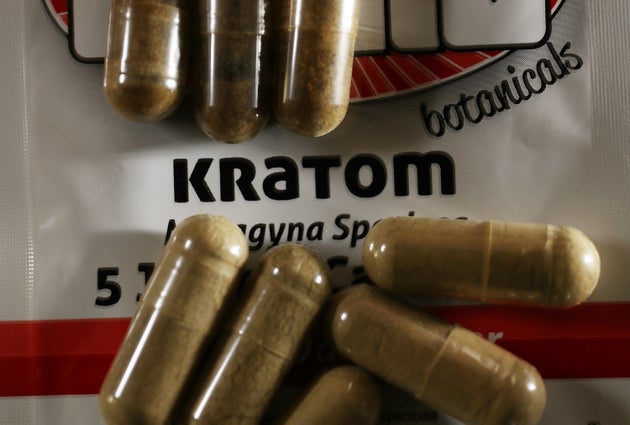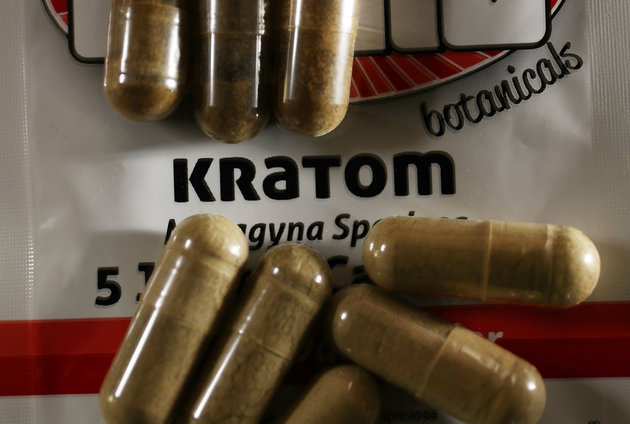The DEA Is Rushing To Criminalize Another Herb, And Congress Is Silent
The DEA Is Rushing To Criminalize Another Herb, And Congress Is Silent
If the war on drugs is a failure, why are lawmakers sitting idly as the DEA launches a ban on kratom?

Nearly half a century into the war on drugs, Americans and their congressional representatives finally seem comfortable challenging the nation’s long-standing enforcement-first drug policy.
Except for when it matters.
With very little to show for the more than $1 trillion spent and millions of lives lost or permanently scarred in the fight for prohibition, lawmakers have begun to push broadly for reform, emphasizing treatment, destigmatization, decriminalization and even legalization over tactics like incarceration and other punitive responses.
But Congress has been silent in the face of an abrupt move by the Drug Enforcement Administration last week to expand the drug war by banning and criminalizing the herbal supplement kratom.
In a notice published in the Federal Register Aug. 31, the DEA announced that it is placing two active ingredients in the herb ― made from the leaves of Mitragyna speciosa, a Southeast Asian tree related to coffee ― into Schedule I under the Controlled Substances Act.
Drugs in this category are considered to have no known medical benefit and a high potential for abuse. Substances classed as Schedule I include heroin, LSD and, most controversially, marijuana. The emergency scheduling move on kratom is set to go into effect as early as the end of September, at which point it will enact a two-year ban that the federal government can make permanent.
The sudden move to ban kratom makes a mockery of the federal government’s claims to be concerned about the suffering unleashed by the opioid epidemic.
The DEA’s attack on another naturally occurring substance attracted immediate pushback from kratom supporters and drug policy experts, who reject the agency’s claim that the herb is an “imminent hazard to public safety.” Kratom users say the DEA ignored anecdotal evidence and emerging science that suggests the drug could be a promising treatment for a variety of ailments, including chronic pain and opioid addiction.
Kratom contains alkaloids that appear to activate opioid receptors in the brain and reduce pain. And although most opioids have sedative qualities, low to moderate doses of kratom actually serve as a mild stimulant. All of this has made it a popular traditional medicine for millennia in Asia and more recently in the West.
The sudden move to ban kratom makes a mockery of the federal government’s claims to be concerned about the suffering unleashed by the opioid epidemic. The White House and members of Congress have been vocal about encouraging doctors to prescribe fewer opiates, but the DEA is banning an herbal alternative that can help do just that ― presumably much to the pleasure of pharmaceutical companies, which would be glad to see the demise of an affordable competitor.
A number of drug policy reform advocates have called out the federal government for once again rushing toward prohibition, a strategy that has repeatedly proven more harmful than helpful. But congressional lawmakers have yet to say anything about this escalation of the drug war.
Although the DEA has the authority to enact this “emergency” policy, Congress could use its upcoming spending bill to block it from doing so. But the political will would have to be there.
The Huffington Post reached out to Congress’ most progressive voices on drug policy for comment on the kratom ban. Some declined to comment. Others didn’t respond at all. The group includes dozens of members, including Sen. Bernie Sanders (I-Vt.), Sen. Elizabeth Warren (D-Mass.), Rep. Justin Amash (R-Mich.) and Rep. Dana Rohrabacher (R-Calif.), all of whom have been vocal supporters of reforming marijuana laws. Since relatively few Americans use kratom, it’s not clear if these lawmakers are entirely aware of what’s going on.
“There’s not been substantial or overwhelming interest from our congressional affairs counterparts, but we are in the eve of pre-election campaigning and members of Congress just came back this week,” Russ Baer, a spokesman for the DEA, told HuffPost. “We suspect there will be an ongoing dialogue in terms of educating members of Congress regarding our intent to schedule kratom.”
But with potentially just three weeks left until the scheduling change for kratom takes effect, the DEA’s actions have so far been subject to minimal oversight. The agency didn’t ask for public comment ahead of its announcement, and the founder of one of the nation’s largest kratom advocacy groups told HuffPost she didn’t hear the news until she read it online last week.
One watchdog is now questioning how the ban materialized. In a letter published Thursday, the Center for Regulatory Effectiveness, a for-profit think tank that has been a persistent thorn in the side of government regulators, asked the DEA for a copy of the administrator’s correspondence with the Department of Health and Human Services. The DEA says it informed HHS of its plan to ban kratom in May, and that the assistant secretary of HHS didn’t object. The Center wants to make sure the process complied with the Data Quality Act, a controversial statute that requires federal regulatory actions to be based on “quality” data.
The lack of scrutiny over this action is troubling, especially considering the widespread implications of a DEA offensive against thousands of Americans who are already using kratom for treatment, as well as manufacturers and distributors in the U.S. and abroad. Furthermore, critics are concerned that the agency used isolated reports to make a series of inaccurate and alarmist claims about kratom, while simultaneously ignoring emerging science that suggests the herb could have a variety of medical benefits.
“Congress has oversight over the DEA and has the responsibility to question the agency and its actions,” said Grant Smith, deputy director of national affairs for the Drug Policy Alliance, a nonprofit that advocates for progressive reform of drug laws.
“In this case, we have a lot of anecdotal evidence that kratom has therapeutic potential, yet the DEA is intending to put this in Schedule I, which is designated for compounds that have no medical value,” Smith continued. “It also is a schedule that is reserved for drugs with a high potential for abuse, yet the research I’ve seen doesn’t corroborate that.”
Indeed, while initial studies have found that kratom could have some addictive potential, they have pointed to possible medicinal applications as well. Most scientific literature has also noted that the plant has a low potential for abuse or acute harm, such as overdose.
Walter Prozialeck, a professor of pharmacology at Midwestern University who wrote a comprehensive literature review on kratom for The Journal of the American Osteopathic Association, previously told HuffPost that he found kratom doesn’t produce much of a psychoactive high when taken in low or moderate doses. This means, he said, it doesn’t appear to have a particularly high potential for recreational use.
Other scientists are more optimistic about how kratom interacts with the human body. Andrew Kruegel, a researcher at Columbia University, has been examining the chemistry of the active alkaloids in kratom, and earlier this year published a study with some fascinating findings.
Here’s how Eric Boodman explained Kruegel’s results in a recent article for the medical news site Stat:
When an opioid binds to a receptor, it can trigger a few different responses in a cell. One is thought to be responsible for causing pain relief. Another is thought to be responsible for the negative side effects, such as respiratory depression, which is responsible for many opioid deaths.
Standard opioids, such as morphine, oxycodone, and fentanyl, set both of these protein cascades into motion.
By using fluorescent molecules to watch the proteins in action, Kruegel’s team could see that the main components of kratom mostly stimulated the painkilling response, but didn’t have as much of an effect on the proteins that caused the side effects.
It’s with this in mind that Kruegel and a number of his colleagues in the medical field wrote a letter to government officials last week expressing “grave concern” over the DEA’s plan to ban the active substances in kratom. The doctors say these alkaloids could lead to the development of safer alternative pain medications that could help address a nationwide opioid epidemic largely fueled by narcotic painkillers. Furthermore, they claim to have seen little evidence to support the DEA’s dire warnings about kratom’s dangers.
“Hundreds of years of human use worldwide further suggest, albeit in an anecdotal manner, that kratom is typically safe, with no substantiated fatal overdoses from kratom plant consumption alone (in contrast to >18,000 deaths per year from prescription opioids and >10,000 from heroin),” they write.
This directly challenges the DEA’s description of kratom as an urgent public health threat, a conclusion that relies heavily on a recent report by the Centers for Disease Control and Prevention.
The CDC study, published in July, found that 660 calls involving kratom were made to U.S. poison centers in the six years from January 2010 to December 2015. It also found evidence of 555 positive drug test results for kratom from December 2014 through March 2016.
Although the DEA claims that a sharp upward trend over this period shows “growing abuse and popularity of these substances,” these incidents make up just a tiny portion of the more than 3 million annual calls to poison centers, and of the millions of drug tests the CDC surveyed over that period. For comparison, poison centers gets tens of thousands of calls each year regarding exposure to laundry detergent packets, glow sticks and other plant matter. In 2014, about 57 percent of all poison center cases involved pharmaceuticals. The CDC declined a request for further comment on this study.
The DEA also claims there have been “numerous deaths associated with kratom,” but fails to provide an example in which the herb was found to be the only contributor. Such a case does not appear to exist. Most deaths associated with kratom have involved people who reportedly tested positive for numerous substances or were suffering from pre-existing medical conditions. Users report that consuming too much kratom will only lead to nausea and vomiting.
Despite the relatively low risk profile, many advocates say they, like the DEA, are worried about emerging brands of “gas station” kratom ― often brightly marked products with stupid names that may be deceptively labeled or contain unlisted adulterants. Before the DEA announced the ban, kratom groups were regularly speaking out in support of regulatory efforts to rein in unscrupulous manufacturers and restrict use by young consumers.
The federal government’s move will put an end to such efforts at nuanced regulation. In its notice, the DEA states that “kratom does not have an approved medical use in the United States and has not been studied as a treatment agent.” But that’s pretty much of true of all herbal supplements sold in the U.S. Obtaining official medical approval from the Food and Drug Administration is a lengthy and painstaking process than can cost pharmaceutical companies billions of dollars. And Big Pharma has little incentive to seek approval for plants like kratom, as corporations can’t exactly patent leaves and naturally occurring compounds that have been around for millions of years.
None of this is to say that we don’t need further research to get a more complete understanding of the potential health benefits or consequences of taking kratom. In fact, on that there appears to be a consensus from people on all sides of the issue.
“In the absence of rigorous, scientific, peer-reviewed clinical studies, DEA is obligated to protect the public and schedule this substance,” said Baer, the agency spokesman.
Of course, as scientists like Kruegel have argued, placing kratom in Schedule I is likely to seriously kneecap that undertaking.
There are also unanswered questions about how the drug enforcement apparatus will approach a newly criminalized drug. Federal penalties for possession, distribution or manufacture of a Schedule I controlled substance are likely to go into effect almost immediately following the change.
This could have broader effects on the criminal justice system, as thousands of Americans will soon be forced to make painful and difficult choices. Many people who use kratom are suffering from chronic pain, and turned to the herb after experiencing negative side effects from prescription opioids, often including addiction. They’ll now have to decide if they want to continue using kratom and risk severe legal consequences. Some may turn back to the painkillers that had previously left them addicted or debilitated. Others may attempt to forgo treatment altogether.
Whatever happens, says Grant Smith, Congress will need to play an active role in this decision. After all, Congress gave the DEA the power to make emergency scheduling decisions, and later enhanced that authority as part of legislation meant to address a spate of emerging synthetic drugs.
Proponents of progressive criminal justice and drug policy reform now have more sway than ever. For their ranks in Congress to remain silent as the DEA moves unopposed to ramp up the drug war yet again would be a huge mistake, Smith said.
“Here we are talking about sentencing reform on Capitol Hill with respect to these older drugs that have been scheduled for a long time, and here comes a drug that is perceived as new, even though it’s not, and we’re applying the same old failed approach of criminalization,” he said. “It’s an unfortunate paradigm. On one hand we’re recognizing that harsh long prison sentences have been counterproductive, but on the other hand you have efforts to continue in this same vein with respect to kratom and some of these other synthetic drugs as well.”






